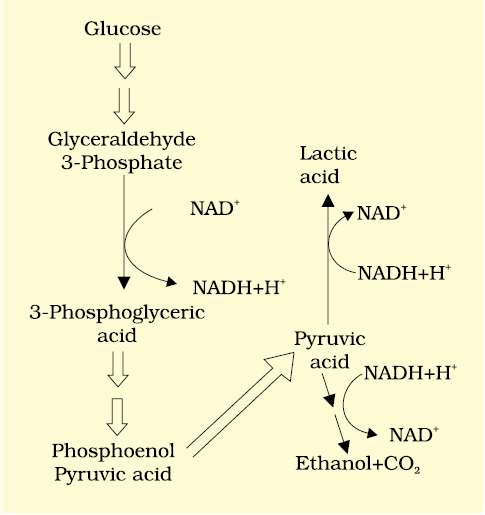In fermentation, say by yeast, the incomplete oxidation of glucose is achieved under anaerobic conditions by sets of reactions where pyruvic acid is converted to CO2 and ethanol. The enzymes, pyruvic acid decarboxylase and alcohol dehydrogenase catalyse these reactions. Other organisms like some bacteria produce lactic acid from pyruvic acid. The steps involved are shown in Figure 14.2. In animal cells also, like muscles during exercise, when oxygen is inadequate for cellular respiration pyruvic acid is reduced to lactic acid by lactate dehydrogenase. The reducing agent is NADH+H+ which is reoxidised to NAD+ in both the processes.

Figure 14.2 Major pathways of anaerobic respiration
In both lactic acid and alcohol fermentation not much energy is released; less than seven per cent of the energy in glucose is released and not all of it is trapped as high energy bonds of ATP. Also, the processes are hazardous – either acid or alcohol is produced. What is the net ATPs that is synthesised (calculate how many ATP are synthesised and deduct the number of ATP utilised during glycolysis) when one molecule of glucose is fermented to alcohol or lactic acid? Yeasts poison themselves to death when the concentration of alcohol reaches about 13 per cent. What then would be the maximum concentration of alcohol in beverages that are naturally fermented? How do you think alcoholic beverages of alcohol content greater than this concentration are obtained?
What then is the process by which organisms can carry out complete oxidation of glucose and extract the energy stored to synthesise a larger number of ATP molecules needed for cellular metabolism? In eukaryotes these steps take place within the mitochondria and this requires O2. Aerobic respiration is the process that leads to a complete oxidation of organic substances in the presence of oxygen, and releases CO2, water and a large amount of energy present in the substrate. This type of respiration is most common in higher organisms. We will look at these processes in the next section.